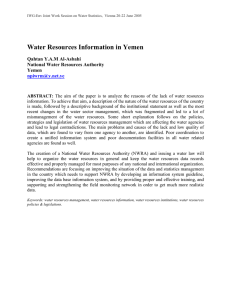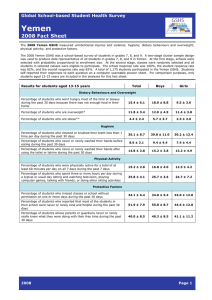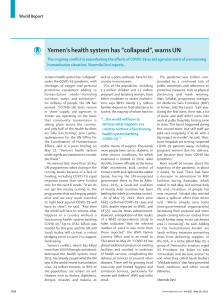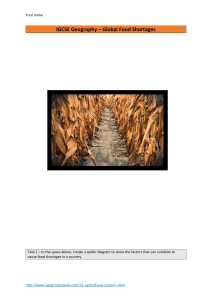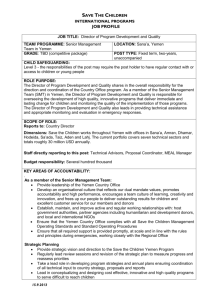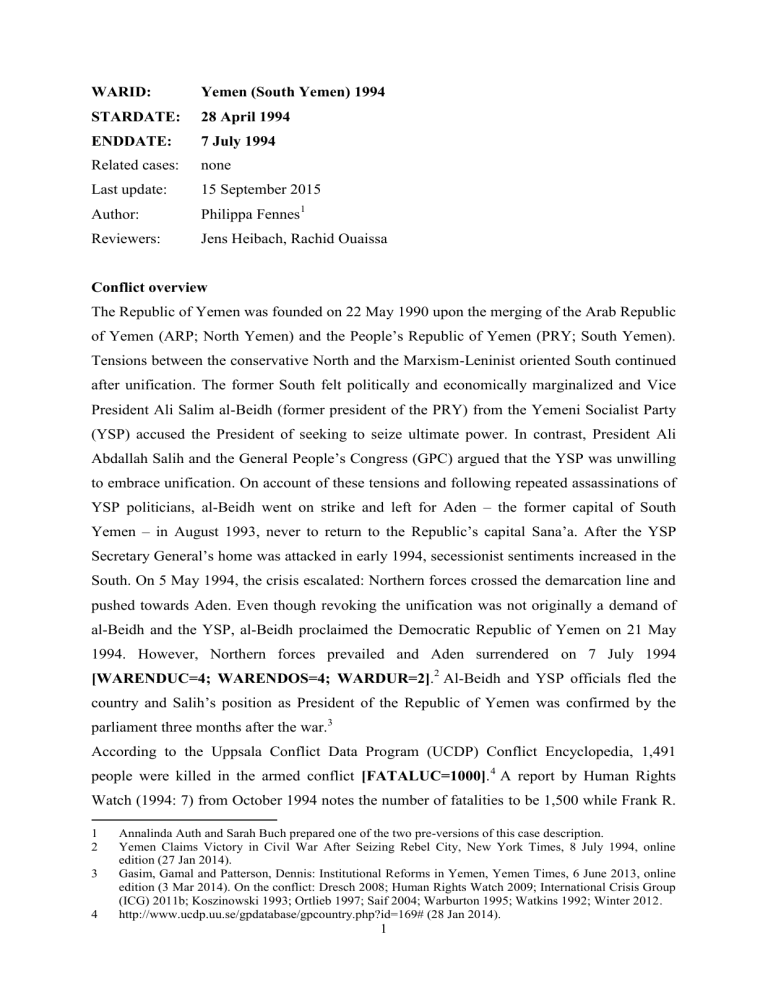
WARID: Yemen (South Yemen) 1994 STARDATE: 28 April 1994 ENDDATE: 7 July 1994 Related cases: none Last update: 15 September 2015 Author: Philippa Fennes1 Reviewers: Jens Heibach, Rachid Ouaissa Conflict overview The Republic of Yemen was founded on 22 May 1990 upon the merging of the Arab Republic of Yemen (ARP; North Yemen) and the People’s Republic of Yemen (PRY; South Yemen). Tensions between the conservative North and the Marxism-Leninist oriented South continued after unification. The former South felt politically and economically marginalized and Vice President Ali Salim al-Beidh (former president of the PRY) from the Yemeni Socialist Party (YSP) accused the President of seeking to seize ultimate power. In contrast, President Ali Abdallah Salih and the General People’s Congress (GPC) argued that the YSP was unwilling to embrace unification. On account of these tensions and following repeated assassinations of YSP politicians, al-Beidh went on strike and left for Aden – the former capital of South Yemen – in August 1993, never to return to the Republic’s capital Sana’a. After the YSP Secretary General’s home was attacked in early 1994, secessionist sentiments increased in the South. On 5 May 1994, the crisis escalated: Northern forces crossed the demarcation line and pushed towards Aden. Even though revoking the unification was not originally a demand of al-Beidh and the YSP, al-Beidh proclaimed the Democratic Republic of Yemen on 21 May 1994. However, Northern forces prevailed and Aden surrendered on 7 July 1994 [WARENDUC=4; WARENDOS=4; WARDUR=2].2 Al-Beidh and YSP officials fled the country and Salih’s position as President of the Republic of Yemen was confirmed by the parliament three months after the war.3 According to the Uppsala Conflict Data Program (UCDP) Conflict Encyclopedia, 1,491 people were killed in the armed conflict [FATALUC=1000]. 4 A report by Human Rights Watch (1994: 7) from October 1994 notes the number of fatalities to be 1,500 while Frank R. 1 2 3 4 Annalinda Auth and Sarah Buch prepared one of the two pre-versions of this case description. Yemen Claims Victory in Civil War After Seizing Rebel City, New York Times, 8 July 1994, online edition (27 Jan 2014). Gasim, Gamal and Patterson, Dennis: Institutional Reforms in Yemen, Yemen Times, 6 June 2013, online edition (3 Mar 2014). On the conflict: Dresch 2008; Human Rights Watch 2009; International Crisis Group (ICG) 2011b; Koszinowski 1993; Ortlieb 1997; Saif 2004; Warburton 1995; Watkins 1992; Winter 2012. http://www.ucdp.uu.se/gpdatabase/gpcountry.php?id=169# (28 Jan 2014). 1 Pfetsch (1996: 237) states a death toll of 10,000 to 15,000. We settle for Pfetsch’s more conservative figure [FATALOS=10000]. World Bank estimates put Yemen’s pre-war population in 1993 at 13.7 million [PREWARPO=13700000].5 Thus, the war killed 0.01% to 0.07% of the pre-war population, depending on the fatality figure used [INTENSUC=0.01; INTENSOS=0.07]. The military balance at the end of the war President Salih and the (former) Northern army emerged as the military victor: the (former) Southern armed forces were mostly dismissed and partly incorporated by the North after the war (Human Rights Watch 2009: 12; Warburton 1995: 20; Winter 2012: 3).6 The YSP was severely weakened and its leaders went into exile. Nevertheless, the YSP remained the second most important opposition party over the years [VICTORY= -1].7 According to Cunningham et al. (2009), the Southern forces can be said to have controlled territory in the borders of the former PRY during the war. However, case-specific literature only provides information on strategies aimed at mobilizing people in the South against the North and at controlling oil revenues. It does not describe whether such attempts were actually successful (Ferschl 1995: 99; Kutschera 1994: 20; Ortlieb 1997: 127-128; Schmitz 1995: 35). Either way, by the end of the war, the Southern forces did not control any territory [REBTERR= -1; MORETERR= -1]. Cunningham et al. (2009) define the South’s fighting capabilities as moderate [REBFIGHT=0]. The Northern forces – including the regular army and large squads of tribal and Islamist militias – rapidly invaded Southern territory and were able to establish a circumvallation around Aden within days after the beginning of the war. Southern ammunition was quickly exhausted and Aden only surrendered after a month of siege and constant bombardment (Ortlieb 1997: 127). The Southern forces were unable to hold their territory in the final weeks of the conflict [CONFIGHT= -1].8 Neither President Salih nor Vice President al-Beidh were killed in the course of the conflict [LEADER=0]. To summarize, the military imbalance at the end of the war was to the benefit of Salih’s government and the Northern forces [WARBAL= -0.67]. The military balance in the post-war period 5 6 7 8 http://api.worldbank.org/v2/en/country/uga?downloadformat=excel (2 Jun 2014). Farhat, Jomana: South Yemen: Unification Dream Becomes Nightmare, Alakhbar, 13 Nov 2012, online edition (3 Mar 2014). Saif 2004: 3. Cieslik 2001: 212. 2 While the yearbooks by the International Institute for Strategic Studies (IISS) (1995-2012) do not differentiate between former Southern and former Northern forces in the unified military after the civil war, case-specific literature outlines the dismantling of the South’s military command and the forced retirement of employees from the Southern army and public services (Winter 2012: 2). Estimates of forced retirement range from 100,000 (Human Rights Watch 2009: 15) to about 468,000.9 The military and security personnel in the South were replaced by Northerners [STATEFOR 1994-2012= -1].10 Along with the regular army and police force, several other security forces were established by President Salih throughout the years, including the 1st Armored Division, the Republican Guard, the Special Forces, the Special Guard and the paramilitary Central Security Forces (Human Rights Watch 2009: 13-14; Winter 2012: 4-5). From 2007 onwards, a movement in the South developed demanding an end to the continued marginalization of the South. This movement, the ‘Hirak al-Janoubi’, a loose coalition of Southern rights groups, gained broad support among Yemeni society in the South by 2009; Southern independence became the goal of several groups affiliated with the Hirak since then (ICG 2013: i). While the movement generally promoted non-violence, armed clashes were noted. An ICG report (2011a: 20) mentions the so called ‘Movement for Self-Determination’, or ‘Hatam’, as Hirak’s armed wing that comprised a few hundred people. However, this group does not appear in the ‘Military Balance’ overview of non-state armed groups or in any case-specific literature. The only exception is a paper by Salisbury (2013) in which the Hirak is described as a “militia formed after the civil war which has fought with the Yemeni military on a number of occasions in the past”. While the Hirak was a Southern movement, it did not represent a successor of the old YSP that had existed until 1994 [SEPFORCE 1994-2012= -1]. 11 Given that the Southern army was dismantled after the civil war and Hirak did not command a separate force based on the YSP tradition, we do not assess the balance of arms and troops between the government and Hirak [ARMS 1994-2012=n.r.; TROOPS 1994-2012=n.r.]. After the end of the war, the North immediately seized Southern territory. However, as the reviewers of this case description clarified, military control over the South was lost when Salih became unable to uphold a comprehensive patronage system at the end of the 2000s and, more importantly, when he redeployed troops to the North in the wake of the 2011 uprisings. Consequently, the Hirak, the tribes, al-Qaida on the Arabian Peninsula (which 9 10 11 Farhat, Jomana: South Yemen: Unification Dream Becomes Nightmare, Alakhbar, 13 Nov2012, online edition (3 Mar 2014). Longley/al-Iryani 2008: 3. http://www.aphref.aph.gov.au_house_committee_pjcis_six.pdf/ (27 Jan 2014) 3 occasionally managed to control major southern cities and even entire governorates temporarily) and the ‘popular committees’ became more powerful. Former YSP rebels did not benefit from this development. Despite Salih’s resignation in 2012 and the fact that Southerner Abd Rabbuh Mansur Hadi became President, “established political actors” remained in power due to corruption and the patronage system in Yemen.12 Ultimately, the former Northern-based regime remained in control [TERRCON 1994-2012= -1; TERRWIN 1994-2012= -1].13 Concerning the issue of vulnerability, we assume that the party that did not control any territory was more vulnerable [VULNERAB 1994-2012= -1]. There were no peacekeeping missions deployed in Yemen after 1994 [PEACKEEP 19942012=n.r.].14 None of the five permanent members of the UN Security Council announced any intention of allying with one side in the case of a renewed civil war [P5ALLY 19942012=n.r.]. In sum, the military balance after the end of the conflict was quite stable [POSTBAL 19942012= -1]. The combined value of the military balance at the end of the war and in the postwar period also shows a clear advantage for the government [BALANCE 1994-2012= -0.83]. Economy The gross domestic product (GDP) per capita in the post-war period started at a very low level and quintupled by 2012. Table 1: GDP per capita in post-war in Yemen in current USD15 Year 1994 1995 1996 1997 1998 1999 2000 2001 2002 2003 2004 2005 2006 2007 12 13 14 15 Population (total) 14,396,720 15,018,201 15,578,640 16,088,019 16,564,235 17,035,531 17,522,537 18,029,989 18,551,068 19,081,306 19,612,696 20,139,661 20,661,714 21,182,162 GDP per capita 289 284 371 425 382 449 550 547 576 617 707 832 924 1210 Hill, Ginny: Pitfalls ahead despite Saleh quitting power in Yemen, BBC, 12 November 2011, online edition (3 Mar 2014). Even though Salih and the Northern forces did not win additional territory after 1994, we settled for these coding decisions. Otherwise, the fact that the South did not hold any territory until 2010 would incorrectly be coded as a compensating factor in the calculation for the post-war military balance. Fortna 2008: 45; http://www.un.org/en/peacekeeping/documents/operationslist.pdf (16 Feb 2015). http://data.worldbank.org/country/yemen-republic (15 Apr 2015). 4 2008 2009 2010 2011 2012 21,703,571 22,229,625 22,763,008 23,304,206 23,852,409 1401 1252 1395 1253 1341 The scale of compromise after the war According to the Yemeni Constitution of 1991 that was approved by a popular referendum, executive power was shared by a Presidential Council consisting of five members and a Council of Ministers.16 However, in September 1994, some months after the end of the civil war, an amendment was passed that led to the Presidential Council being replaced by a oneman presidency, namely by Salih (Saif 2004: 4). While Salih was not officially elected President until 1999, he and the mainly Northern-based GPC had de facto controlled the Republic of Yemen since its founding (Day 2008: 422; Phillips 2011: 106). In 2006, all 32 members of the Council of Ministers came from the GPC [GOVERN 1994-2011= -1].17 In December 2011, the ‘Agreement on the Implementation Mechanism for the Transition Process in Yemen in Accordance with the Initiative of the Gulf Cooperation Council’ (2011) was signed in reaction to a sustained protest campaign. It prescribed the formation of a unity cabinet with members of the GPC and the Joint Meeting Parties (Agreement: III.10). The Joint Meeting Parties (JMP) were dominated by the Islamist Party Islah, while the YSP was the second-strongest party in this alliance (ICG 2012: 1, FN 3).18 According to the Agreement (2011: III.10 and III.10a), the cabinet was equally divided between the GPC and the JMP. The latter had to nominate the Prime Minister. Salih formally stayed in power until 27 February 2012 when he was succeeded by his Vice President Abd Rabbuh Mansur Hadi [GOVERN 2012=0].19 Until the end of 2011, Salih and the GPC dominated state institutions. The constitution did not install any veto mechanisms that could be used by the YSP or other opposition groups [VETO 1994-2011= -1; VETOSAT 1994-2011=n.r.].20 The mentioned Agreement on the Transition Process (2011: III.12) stated: “The government of national unity shall take its decisions by consensus. If there is no full consensus on any given matter, the Prime Minister shall consult with the Vice President or, after the early presidential elections, the President, in order to reach consensus. If consensus between them is not possible, the Vice President or, 16 17 18 19 20 Carnegie Endowment for International Peace 2007; http://www.constitutionnet.org/country/constitutionalhistory-yemen#Executive_branch (25 Jan 2014). Carnegie Endowment for International Peace 2007. According to the ICG, the JMP consisted of only five parties. Our reviewers, however, point to a sixth party. Saleh hands over Yemen reins to successor, Aljazeera, 27 February 2012, online edition (27 Jan 2014). Constitution of the Republic of Yemen 1994; Philips 2008: 79-81. 5 after the early presidential elections, the President, shall take the final decision”. As a consequence, the JMP along with the YSP were without a veto position [VETO 2012= -1; VETOSAT 2012=n.r.].21 After the war, parliamentary elections took place in 1997 and 2003 and presidential elections were held in 1999, 2006 and 2012. In 1997, the “YSP boycotted these elections because its assets had been confiscated after the 1994 war and had not been returned, thus rendering any campaigning impossible” (Bertelsmann Transformation Index (BTI) 2006: 3; Saif 2004: 8). Due to this boycott, the YSP could not nominate its candidate for the presidential election in 1999 [ELECT 1994-2002= -1].22 In 2003 and 2006, the YSP was able to take part in the elections. With respect to the year 2003, Freedom House declared: “Citizens of Yemen cannot change their government democratically”.23 Thus, despite the YSP’s participation, there were no basically free and fair elections [ELECT 2003-2006= -1]. For 2007, the assessment somewhat improved: “The country appears to have a relatively open democratic system, with citizens voting for president and members of Parliament. However, Yemen’s politics are dominated by the ruling GPC party”. 24 The coding decision reflects this development [ELECT 2007-2011=0]. In February 2012, the unity government jointly recommended Hadi for President, who ran unopposed [ELECT 2012=0].25 Since the newly proclaimed Democratic Republic of Yemen was immediately incorporated by the North and continues to be part of the Republic of Yemen, no compromise with regards to the Southern demand for secession was reached; the former North and former South remain unified [EXBORDER 1994-2012= -1].26 Questions of federalism or other sub-state entities were not part of the conflict [INBORDER 1994-2012=n.r.]. Concerning other demands made by the South, al-Beidh formulated 18 demands (Ortlieb 1997: 125) that were all accepted by the government in form of the ‘Document of Pledge and Accord’ (DPA) signed by Salih and al-Beidh in January 1994. The DPA was composed by the ‘Political Forces Dialogue Committee’ – established in November 1993 as an attempt to prevent the escalation of the political tensions between the former North and former South. The Committee failed to circumvent conflict as the war broke out only two months after the signing of the DPA. Nevertheless, the DPA and the 18 Points on which it was based provide insights into the main demands of the South. First and foremost, it demanded the diffusion of 21 22 23 24 25 26 We also point out that the JMP held only 63 seats in the 301-member parliament (ICG 2012: 2, FN 9). BTI 2006: 3. https://freedomhouse.org/report/freedom-world/2004/yemen#.VS_Zv5OynXE (16 Apr 2015). https://freedomhouse.org/report/freedom-world/2007/yemen#.VS_Y-JOynXE (16 Apr 2015). https://freedomhouse.org/report/freedom-world/2013/yemen#.VS_ajZOynXE (16 Apr 2015). Ortlieb 1997; Yemen: Federation Plan Offers South More Autonomy, New York Times, 10 February 2014, online edition (3 Mar 2014). 6 authority (Ortlieb 1997: 125). The DPA called for the creation of a democratic system of local governments that would amount to an “administrative and financial decentralization in a unified state” (Whitaker 2009). After the war, no such structures were implemented and power continued to be centralized. By February 2014, President Hadi demonstrated a willingness to decentralize power by approving a plan to make Yemen a federal country that grants the South more autonomy [COMPETEN 1994-2012= -1].27 Moreover, Al-Beidh called for the control of corruption, bribery and administrative abuse (Ortlieb 1997: 125) along with the implementation of financial and administrative reforms in order to achieve balanced economic development (Whitaker 2009). However, while such reforms have been implemented, such as the administrative reform of 1998, they were superficial and did not change the core of the economic system (Al Assad 2010). A World Bank (2006) evaluation notes that the quality of bureaucracy in Yemen did not improve between 1998 and 2004. Instead, the system was still characterized by corruption and clientelism [ECONOMY 1994-2012= -1].28 As a final point, al-Beidh demanded the restructuring of the army and security forces (Ortlieb 1997: 125). The power of the military was to be reduced, especially within city boundaries, and the police’s security responsibilities were to be extended. Generally, the security forces of the former South and former North were to be merged and to be “void of any sectarian, regional, familial or tribal influence”.29 Again, these demands were not met after the victory of the Northern forces: the military continued to be closely intertwined with the government and remained the main provider of internal security together with several small security units (as opposed to the police) established by Salih (Winter 2012). Instead of merging the armed forces, the former Southern forces were mostly dissolved and replaced by Northerners. These developments have already been considered in our assessment of the post-war military balance [ISSUE 1994-2012=n.r.; ISSUE2 1994-2012=n.r.].30 There were no demands made regarding special programs promoting the South [SPECPRO 1994-2012=n.r.]. While complaints of the South’s marginalization, as voiced before the civil war, continued after the war, a new issue regarding pension payments was raised by a group of army pensioners in 2007. This was voiced by the so-called ‘Society of Retired Military Officers’ and eventually turned into a much larger movement, the Hirak, as described above (Human Rights Watch 2009: 15). Even though the government eventually did pay some pensions, 27 28 29 30 Yemen: Federation Plan Offers South More Autonomy, New York Times, 10 February 2014, online edition (3 Mar 2014). Phillips 2011: 54-58. http://www.al-bab.com/yemen/pol/pledge.htm (25 Jan 2014). Longley/al-Iryani 2008: 3. 7 “some 100,000 retired southern military officers and civil servants only sporadically received their pensions” (Human Rights Watch 2009: 12). Only a small portion of Southern retirees were affected by this and only received a small portion of their pensions; we therefore do not take this to be an actual compromise [NEWCON 1994-2006=n.r., NEWCON 2007-2012= 1; NEWCON2 1994-2012=n.r.]. As the points above show, Salih’s government was not willing to compromise with regards to any of the South’s demands [BENEFIT 1994-2012=n.r., BENEFIT2 1994-2912=n.r.]. In sum, the interests of the government clearly prevailed throughout the post-war period. The dominance of the GPC did, however, somewhat diminish [COMPROM 1994-2006= -1, COMPROM 2007-2011= -0.86, COMPROM 2012= -0.71]. Stability of peace A war between the government and the Southern-based YSP did not recur. Even though people died in violent encounters between the Hirak and government forces, the number of fatalities did not reach the threshold of a civil war [SAMEWAR 1994-2012=0; DATESAME=n.r.]. 31 Thus, until December 2012, 221 months of peace were counted [PEACMON1=221]. However, throughout the 2000s, the Yemeni government was challenged by groups other than the Hirak, among them Al-Qaeda in the Arabian Peninsula (AQAP). According to the UCDP, this conflict crossed the threshold of a civil war in December 2009 [ANYWAR 1994-2012=1; DATEANY=17 Dec 2009; PEACMON2=185].32 References Agreement on the Implementation Mechanism for the Transition Process in Yemen in Accordance with the Initiative of the Gulf Cooperation Council 2011, in: International Crisis Group: Yemen: Enduring Conflicts, Threatened Transition, Crisis Group Middle East Report N°125, Sanaa and Brussels, 33-38. Al-Assad, Morheb 2010: Public Administration Reform: The Case of Yemen, University of Aden, Faculty of Administrative Sciences http://www.uafas.com/Media/%D9%85%D8%AC%D9%84%D8%A9%20%D8% A7%9%84%D8%B9%D9%84%D9%88%D9%85%20%D8%A7%D9%84%D8%A7%D8%AF%D8%A7% D8%B1%D9%8A%D8%A9%202010/%D8%A7%D9%84%D8%B9%D8%AF%D8%AF2/Dr.%20Morheb %20Al-Assad,.pdf (29 Jan 2014). Bertelsmann Transformation Index 2006: Yemen, http://www.bti-project.de/fileadmin/Inhalte/ reports/2006/pdf/BTI%202006%20Yemen.pdf (16 Apr 2015). Carnegie Endowment for International Peace 2007: Arab Political Systems: Baseline Information and Reforms – Yemen, http://carnegieendowment.org/files/Yemen_APS.doc (15 Jan 2014). 31 32 http://www.ucdp.uu.se/gpdatabase/gpcountry.php?id=169&regionSelect=10-Middle_East# (15 Apr 2015). UCDP/PRIO Armed Conflict Dataset v.4-2014, 1946-2013, cell P364, http://www.pcr.uu.se/research/ ucdp/datasets/ucdp_prio_armed_conflict_dataset/ (15 Apr 2015). On how the UCDP assesses the Ansaruallah or Huthi rebels: http://www.ucdp.uu.se/gpdatabase/gpcountry.php?id=169&regionSelect=10Middle_East# (15 Apr 2015). 8 Cieslik, Thomas 2001: Wiedervereinigungen während und nach der Ost-West-Blockkonfrontation, Ursachen der Teilung, Grundlagen der (fehlenden) Einheit; untersucht an den Fallbeispielen: Vietnam, Jemen, Deutschland, China und Korea, Marburg. Constitution of the Republic of Yemen 1994, http://www.al-bab.com/yemen/gov/con94.htm (16 Apr 2015). Cunningham, David E./Gleditsch, Kristian Skrede/Salehyan, Idean 2009: It Takes Two. A Dyadic Analysis of Civil War Duration and Outcome, in: Journal of Conflict Resolution, 53: 4, 570-597. Day, Stephen 2008: Updating Yemeni National Unity: Could Lingering Regional Divisions Bring Down the Regime?, in: Middle East Journal, 62: 3, 417-436. Dresch, Paul 2008: A History of Modern Yemen, Cambridge. Ferschl, Dieter 1995: Jemen und Oman, München. Fortna, Virginia Page 2008: Data Notes, http://www.columbia.edu/~vpf4/pk&pkept%20data%20notes.pdf (28 Jan 2014). Human Rights Watch 1994: Yemen. Human Rights in Yemen During and After the 1994 War, in: Human Rights Watch/Middle East, 6:1, http://www.hrw.org/sites/default/files/reports/YEMEN94O.PDF (3 March 2014). Human Rights Watch 2009: In the Name of Unity. The Yemeni Government’s Brutal Response to Southern Movement Protests, http://www.hrw.org/sites/default/files/reports/southyemen1209webwcover.pdf (18 Jan 2014). International Crisis Group 2011a: Breaking Point? Yemen’s Southern Question, Middle East Report N°114, Sanaa and Brussels. International Crisis Group 2011b: Popular Protest in North African and the Middle East (II): Yemen between Reform and Revolution. Middle East Report N°102, Sanaa and Brussels. International Crisis Group 2012: Yemen: Enduring Conflicts, Threatened Transition, Crisis Group Middle East Report N°125, Sanaa and Brussels. International Crisis Group 2013: Yemen’s Southern Question: Avoiding a Breakdown, Middle East Report N°145, Sanaa and Brussels. International Institute for Security Studies (IISS) 1995-2012: The Military Balance, London. Koszinowski, Thomas 1993: Jemen 1992, in: Koszinowski, Thomas/Mattes, Hanspeter (eds.): Nahost Jahrbuch 1992. Politik, Wirtschaft und Gesellschaft in Nordafrika und dem Nahen und Mittleren Osten, Opladen, 9499. Kutschera, Chris 1994: Post mortem, in: The Middle East, 21: 10/238, 19-20. Longley, April/al-Irayani, Abdul Ghani 2008: Fighting Brushfires with Batons: An Analysis of the Political Crisis in South Yemen, in: Middle East Institute Policy Brief, 7, Washington, DC. Ortlieb, Lars. C. 1997: Der Machtkampf der beiden Ali. Gescheiterte Vereinigung und Krieg im Jemen 1994, Universität Hamburg – IPW, Hamburg. Pfetsch, Frank R. (ed.) 1996: Globales Konfliktbarometer 1990-1995, Münster Phillips, Sarah 2011: Yemen and the politics of Permanent Crisis. The International Institute of Strategic Studies, London. Saif, Ahmed Abdelkarrem 2004: The Yemeni Parliamentary Elections. A Critical Analysis, Dubai. Salisbury, Peter 2013: Yemen’s Southern Intifada, in: Foreign Policy, http://mideastafrica.foreignpolicy.com/posts/2013/03/13/yemen_s_southern_intifada (3 Mar 2014). Schmitz, Chuck 1995: Civil War in Yemen: The Price of Unity?, in: Current History, 94: 588, 33-36. Warburton, David 1995: The Conventional War in Yemen, in: Arab Studies Journal, 3:1, 20-44. Watkins, Eric 1992: Democracy against the odds, in: The Middle East, 19: 12, 9-11. Whitaker, Brian 2009: The Birth of Modern Yemen, http://www.albab.com/yemen/ birthofmodernyemen/ bmy11.htm (18 Mar 2014). Winter, Lukas 2012: Restructuring Yemen’s Military Leadership. Foreign Military Studies Office, http://fmso.leavenworth.army.mil/documents/Restructuring-Yemen-Military.pdf (2 Mar 2014.) World Bank 2006: Republic of Yemen, Country Assistance Evaluation, Washington, DC. 9
